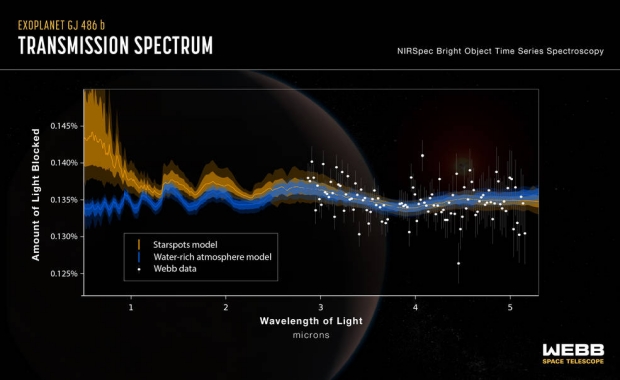I might have mentioned the issues involving the James Webb Space Telescope’s MIRI instrument in my earlier post on in-flight maintenance and repair. MIRI is the Mid-Infrared Instrument that last summer had issues with friction in one of the wheels that selects between short, medium and longer wavelengths. Now there seems to be a problem, however slight, that affects the amount of light registered by MIRI’s sensors.
The problems seem minor and are under investigation, which is a good thing because we need MIRI’s capabilities to study systems like GJ 486, where a transiting rocky exoplanet may or may not be showing traces of water in an atmosphere that may or may not be there. MIRI should help sort out the issue, which was raised through observations with another JWST instrument, the Near-Infrared Spectrograph (NIRSpec). The latter shows tantalizing evidence of water vapor, but the problem is untangling whether that signal is coming from the rocky planet or the star.
This points to an important question. GJ 486b is about 30 percent larger than Earth and three times as massive, a rocky super-Earth orbiting its red dwarf host in about 1.5 Earth days. The proximity to the star almost demands tidal lock, with one side forever dark, the other facing the star. If the water vapor NIRSpec is pointing to actually comes from a planetary atmosphere, then that atmosphere copes with surface temperatures in the range of 430 Celsius and the continual bombardment of ultraviolet and X-ray radiation associated with such stars. That would be encouraging news for other systems in which rocky worlds orbit further out, in an M-dwarf’s habitable zone.
Sarah Moran (University of Arizona, Tucson) is lead author of the study, which has been accepted for publication at The Astrophysical Journal Letters:
“We see a signal, and it’s almost certainly due to water. But we can’t tell yet if that water is part of the planet’s atmosphere, meaning the planet has an atmosphere, or if we’re just seeing a water signature coming from the star.”

Image: This graphic shows the transmission spectrum obtained by Webb observations of rocky exoplanet GJ 486b. The science team’s analysis shows hints of water vapor; however, computer models show that the signal could be from a water-rich planetary atmosphere (indicated by the blue line) or from starspots from the red dwarf host star (indicated by the yellow line). The two models diverge noticeably at shorter infrared wavelengths, indicating that additional observations with other Webb instruments will be needed to constrain the source of the water signal. Credit: NASA, ESA, CSA, Joseph Olmsted (STScI).
The trick here is that we see GJ 486b transiting its star, allowing astronomers to deploy transmission spectroscopy, in which the light of the star passes through a planet’s atmosphere and affords information about which molecules are found there. This is done only after the star’s spectrum without the transiting planet has been observed. Dips in that spectrum during the transits tell the tale, but in this case we can’t be sure of their source. The flat spectrum during transits rises at short infrared wavelengths and water vapor seems to be the culprit, but stars can have water vapor of their own.
Thus starspots can’t be ruled out, even though there is as yet no evidence that the planet crossed any of these during the two transits for which these data were taken. Even a much hotter G-class star like our Sun can show traces of water vapor in sunspots, which are much cooler than the surrounding surface. An M-dwarf like GJ 486 is far cooler than the Sun, making water vapor detections in its starspots possible.
So imagine the scenario. If we do have an atmosphere here, we have to explain how it can exist despite the continual erosion forced by the star’s heat and irradiation. That would lead one to suspect volcanic replenishment as materials are ejected from the planet’s interior. An already scheduled JWST observational program using MIRI will study the planet’s dayside for signs of an atmosphere that can circulate heat. Hence the significance of fine-tuning MIRI’s small glitches to resolve a big question.
In the case that the upcoming MIRI observations cannot definitely detect an atmosphere, high precision shorter wavelength observations could provide evidence for or against an atmosphere on GJ 486b. Ultimately, our JWST NIRSpec/G395H stellar and transmission spectra, combined with retrievals and stellar models, suggest either an airless planet with a spotted host star or a significant planetary atmosphere containing water vapor. Given the agreement between our stellar modeling and atmospheric retrievals for the spot scenario, this interpretation may have a slight edge over a water-rich atmosphere. However, a true determination of the nature of GJ 486b remains on the horizon, with wider wavelength observations holding the key to this world’s location along the cosmic shoreline.
The paper is Moran et al., “High Tide or Riptide on the Cosmic Shoreline? A Water-Rich Atmosphere or Stellar Contamination for the Warm Super-Earth GJ~486b from JWST Observations,” accepted at The Astrophysical Journal Letters and available as a preprint.



